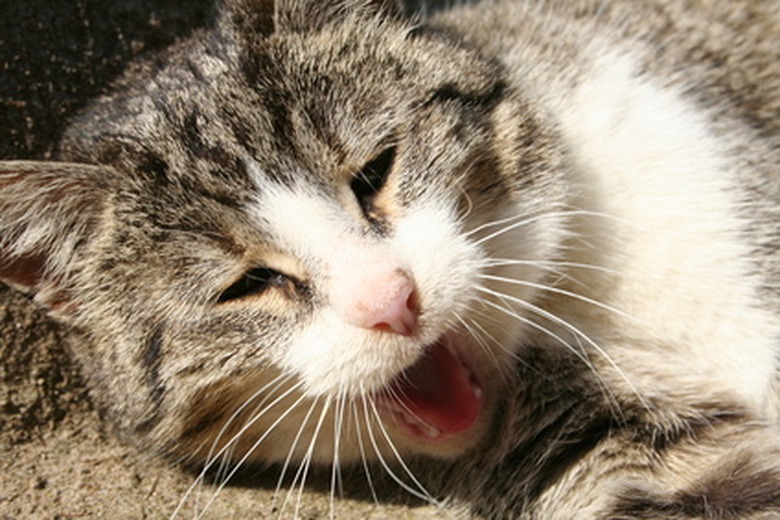Tetracycline Dosage For Cats
Tetracycline is a broad-spectrum antibiotic prescribed by veterinarians to treat different types of feline bacterial infections. It should only be obtained by prescription from a veterinarian who has examined your cat. Beyond antibiotic properties, tetracycline also appears to have anti-inflammatory properties, according to Mar Vista Animal Medical Center. Do not give your cat tetracycline or any other medications without consulting your veterinarian, who will instruct you about proper dosage and how to administer it.
General Information and Precautions
General Information and Precautions
Tetracycline is available in various forms, including an oral suspension liquid, tablets, capsules and a topical solution. For some cats, giving tetracycline is not advised, such as cats with liver or kidney problems or kittens under 6 months old whose teeth may become permanently discolored as a result, according to Dr. Dawn Ruben of the University of Missouri College of Veterinary Medicine. Other side effects include lack of appetite, nausea, vomiting and diarrhea. If your cat has an uncomfortable gastrointestinal reaction, a small amount of food might alleviate the discomfort. Unfortunately, taking this drug with food – especially dairy products — prevents proper absorption of tetracycline into the body.
Liquid Tetracycline
Liquid Tetracycline
Some veterinarians prescribe tetracycline for cats with feline upper respiratory infections, even though the majority of these infections are viral, and antibiotics do not fight viruses. The reason for treating this illness with anti-bacterial medications is that viral infections can be aggravated by secondary bacterial infections. Tetracycline antibiotics can be compounded into an oral suspension solution that cats may accept more readily than a pill. The standard dosage of liquid tetracycline for cats is "25 milligrams per pound of body weight per day in divided doses every 6 hours," according to PetsMedic.org.
Doxycycline
Doxycycline
Doxycycline, a tetracycline derivative, treats conditions such as feline mycoplasma infections. Doxycycline is available in a liquid form that cat owners find easier to give their feline companions. "The typical dose administered to cats is 2.5 mg per pound every 12 hours orally," according to Dr. Mark Papich. The duration of treatment with tetracycline medications depends on the illness being treated. Unless your veterinarian advises otherwise, finish the entire treatment even if your cat seems better. Contact your veterinarian if your cat exhibits side effects or any other unusual behavior.
Tetracycline Tablets and Capsules
Tetracycline Tablets and Capsules
Tetracycline is also available in tablets and capsules. Always follow your veterinarian's instructions about the correct tetracycline dosage for your cat, the number of times per day to administer the medication and the length of time to give her the antibiotic. The proper dosage depends on the cat's weight, medical condition, overall health and potential negative drug interactions. Veterinary pharmacology articles offer divergent recommendations as to the amount of tetracycline per pound of body weight (from 5 to 10 mg/lb. orally), the daily schedule for administration (from 6 to 12 hours between doses) and the duration for the prescribed course of medication (from 14 to 21 days). Abide by your veterinarian's instructions.
Administering Tetracycline to Cats
Administering Tetracycline to Cats
Veterinarians often prescribe tetracycline in liquid form for cats. The medication comes in a container it should be kept in, along with a plastic needleless syringe or eye dropper. Ask your veterinarian to demonstrate how to fill the syringe and request guidelines that will help you medicate your cat. Getting cats to take pills can be extremely difficult. Products created for this purpose include soft, sticky treats in which you can hide a tablet or capsule. Try disguising pills in little balls of your cat's favorite food. "The Cat Owner's Home Veterinary Handbook," published in 2007, says providing your cat with at least 1 teaspoon of water from a syringe or an eyedropper after giving her pills is essential.
Always check with your veterinarian before changing your pet's diet, medication, or physical activity routines. This information is not a substitute for a vet's opinion.
References
- Mar Vista Animal Medical Center: Tetracycline
- Petplace.com: Tetracycline (Panmycin)
- Mar Vista Animal Medical Center: Feline Upper Respiratory Infections
- PetPlace.com: Doxycycline
- Pet Supplies Review: Tetracycline
- VetInfo: How Safe Are Human Antibiotics for Cats?
- Cat Owner's Home Veterinary Handbook; Debra Eldredge, et. al.
